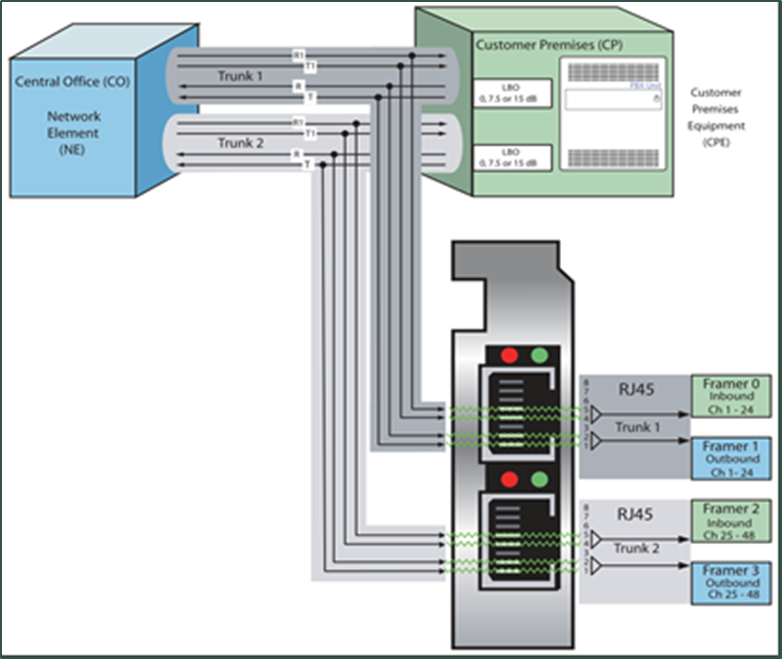Version support: Avaya DP-MLS versions 6.0-7.6 SP10
The Avaya DP-MLS integration uses Ai-Logix passive tap (DP) cards to connect to a T1/E1 trunk as an audio source. Call control events and metadata are received from the MLS server.
|
Component |
Function |
|---|---|
| Avaya Communication Server (CS) 1000 |
PBX component that controls the audio being presented to and from digital phones, IP phones, or both. |
| Avaya Contact Center Manager Server (CCMS) | Supports MLS and provides CTI call events such as start/stop to the Uptivity recording server. |
| AI-Logix DP Voice Board |
Audio capture card(s) installed in the Uptivity recording server. |
| Uptivity Recording Server |
Receives call control events, business data, and audio. Provides a CTI interface for audio recording. Creates call records and manages recording storage. May also host the Web Portal for playback and system administration. |
Wiring Example
inContact recommends that the wiring tap be accomplished through use of a patch panel that will split one input connection into two output connections: one to the PBX and one to the Uptivity recording server. For more information, refer to AudioCodes documentation supplied with the Ai-Logix board or available from your installation team.
Terminology
To ensure a common frame of reference, this guide uses the following terms in conjunction with this Avaya integration:
|
Term |
Definition |
|---|---|
| AACC | Avaya Aura Contact Center. AACC is an Avaya contact center product that is common in VoIP environments and in multi-channel call centers due to its support for non-voice interactions. |
| CS1000 | This is the legacy Nortel contact center PBX. It has been rebranded as Avaya and is still in use. |
| MLS | Meridian Link Services. MLS is a legacy Nortel product that has been rebranded as Avaya and is still widely used. |
| TDM | Time Division Multiplexing. Commonly-used as an acronym for traditional wired telephony, as opposed to VoIP. |
Known Limitations
The Avaya DP-MLS integration does not support the real-time blackout functionality in Uptivity.
Customer Responsibilities
You are responsible for supplying any required physical and IP connections to your telephone system, as well as any licensing required by Avaya. You may also be responsible for configuring Avaya system components to support the recording integration. See your specific integration in the Customer Integration Tasks section for additional information.
If you supply the server hardware for the installation, then you are also responsible for installing the physical Ai-Logix cards in the server.
Avaya Requirements
Hardware
-
Avaya Communication Server (CS) 1000
Software
-
Succession/CS1000 Release 4.5 – 7.5
-
Contact Center Manager Server (CCMS) 6.0 – 7.5
Licensing
-
Contact your Avaya representative concerning licensing requirements for your specific installation.
-
Uptivity Requirements
Hardware
Uptivity hardware requirements vary depending on system configurations. Appropriate hardware is identified during the system implementation process. For additional information, search online help for keyword site requirements.
Along with standard hardware, one or more of the following is specifically required for this integration based on the number of trunks to be recorded:
-
AudioCodes DP 6409 T1/E1 Passive Tap Call Recording Blade
This card is dual-port and can connect to up to two (2) T1/E1 trunks. The number of channels that can be recorded per trunk varies depending on the configuration of the trunk itself:
-
Single T1 — 24 channels (23 channels for ISDN-signaled T1)
-
Dual T1 — 48 channels (46 channels for ISDN-signaled T1)
-
Single E1 — 30 channels
-
Dual E1 — 60 channels
Software
-
NICE Uptivity
Additional third-party software is required for the Ai-Logix digital trunk integration:
-
AudioCodes SmartWORKS v3.11 – 5.4
-
AudioCodes SmartWORKS v5.9 in MS 2012 environments
Licensing
-
One (1) Voice seat license per named agent or
-
One (1) Voice concurrent session license for each simultaneous call that will be recorded
-
Additional licensing may be required if the system includes optional features (for example, Uptivity Screen Recording)
Customer Configuration Overview
- Install the Ai-Logix card(s) in customer-supplied server(s).
- Complete all necessary physical connections between the recording server(s) and the telephony system.
- Complete all necessary physical and IP connections between the recording server(s) and the LAN.
- Obtain any necessary Avaya software and licensing.
- Generate a TN Database List and provide the information to the Uptivity installation team.
- Generate a DN Database List and provide the information to the Uptivity installation team.
|
|
|





